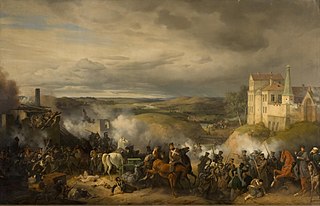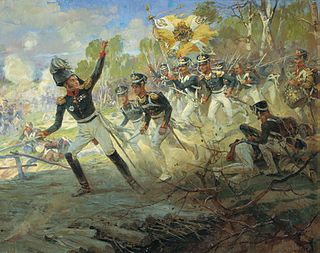
Prince Pyotr Ivanovich Bagration was a Russian general and prince of Georgian origin, prominent during the French Revolutionary and Napoleonic Wars.

The Battle of Borodino took place near the village of Borodino on 7 September [O.S. 26 August] 1812 during Napoleon's invasion of Russia. The Grande Armée won the battle against the Imperial Russian Army, but failed to gain a decisive victory and suffered tremendous losses. Napoleon fought against General Mikhail Kutuzov, whom the Emperor Alexander I of Russia had appointed to replace Barclay de Tolly on 29 August [O.S. 17 August] 1812 after the Battle of Smolensk. After the Battle of Borodino, Napoleon remained on the battlefield with his army; the Imperial Russian forces retreated in an orderly fashion southwards. Because the Imperial Russian army had severely weakened the Grande Armée, they allowed the French occupation of Moscow, using the city as bait to trap Napoleon and his men. The failure of the Grande Armée to completely destroy the Imperial Russian army, in particular Napoleon's reluctance to deploy his Imperial Guard, has been widely criticised by historians as a huge blunder, as it allowed the Imperial Russian army to continue its retreat into territory increasingly hostile to the French. Approximately a quarter of a million soldiers were involved in the battle, and it was the bloodiest single day of the Napoleonic Wars.

The Battle of Valutino took place on 19 August 1812, between a corps of French and allied troops led by Marshal Ney, about 35,000 strong, and a strong rear-guard of General Barclay de Tolly's Russian army of about 25,000, commanded by the general himself. The Russians were strongly posted in marshy ground, protected by a small stream, about 20 kilometers east of Smolensk. The French, attacking resolutely, captured the Russian position in the face of considerable physical obstacles.

The Battle of Maloyaroslavets took place on 24 October 1812 as part of the French invasion of Russia. It was Kutuzov's decisive battle to force Napoleon to retreat northwest over Mozhaisk to Smolensk on the devastated route of his advance with a higher probability of starvation. Kutuzov's next attack against the remnants of the Grande Armée, the Battle of Krasnoi, began on 15 November 1812, three weeks later.

The Battle of Klyastitsy, also called the Battle of Yakubovo or the Battle of Oboiarszina, was a series of military engagements that took place on 30 July–1 August 1812 near the village of Klyastitsy on the road between Polotsk and Sebezh. In this battle, the Russian vanguard under the command of Yakov Kulnev and the whole corps of Peter Wittgenstein stood up to the French corps under the command of Marshal Nicolas Oudinot with heavy losses on both sides. The result was a minor Russian victory, their forces managing to capture the disputed village of Klyastitsy. The French partially retreated along their communication lines after the battle, and fended off Russian pursuers.

In the First Battle of Polotsk, which took place on 17–18 August 1812, Russian troops under the command of Peter Wittgenstein fought French and Bavarian troops led by Nicolas Oudinot near the city of Polotsk, halting Oudinot's advance toward Saint Petersburg. The First Battle of Polotsk should be distinguished from the Second Battle of Polotsk which took place during the same campaign two months later.

The Second Battle of Polotsk took place during Napoleon's invasion of Russia. In this encounter the Russians under General Peter Wittgenstein attacked and defeated a Franco-Bavarian force under Laurent Gouvion Saint-Cyr. In the aftermath of this success, the Russians took Polotsk and dismantled Napoleon's operations in Belarus. Wittgenstein's victory set the stage for the Battle of Berezina in November, in which three Russian armies converged on Napoleon from separate directions.

The Battle of Chashniki, sometimes also called the Battle of Czasniki, was fought during Napoleon's invasion of Russia, on 31 October 1812, between Russian forces under General Wittgenstein, and the French Army, commanded by Marshal Victor. This battle was a failed effort by the French to reestablish their northern "Dvina Line", which had crumbled as a result of Wittgenstein's victory at the Second battle of Polotsk just two weeks earlier.

The Battle of Saltanovka, also known as the Battle of Mogilev, took place on 23 July 1812 during the early stages of the 1812 French invasion of Russia.
The I Corps of the Grande Armée was a French military unit that existed during the Napoleonic Wars. Though disbanded in 1814, following the Treaty of Fontainebleau, it was reformed in April 1815 following the return of Napoléon during the Hundred Days. During the Hundred Days, the corps formed part of the quickly re-formed Army of the North.

The French invasion of Russia, also known as the Russian campaign and in Russia as the Patriotic War of 1812, was initiated by Napoleon with the aim of compelling the Russian Empire to comply with the continental blockade of the United Kingdom. Widely studied, Napoleon's incursion into Russia stands as a focal point in military history, recognized as among the most devastating military endeavors globally. In a span of fewer than six months, the campaign exacted a staggering toll, claiming the lives of nearly a million soldiers and civilians.

This is the order of battle of the French invasion of Russia.

The battle of Vitebsk, sometimes spelled Witepsk, was a military engagement that took place on 26 and 27 July 1812 during the French invasion of Russia. The battle put a French force, under the command of Emperor Napoleon I, in combat with Russian rearguard forces under General Petr Konovnitsyn and Peter von der Pahlen and ended with the Russian forces making a strategic retreat from the battlefield.

The Battle of Kobrin, or the Battle of Kobryn, took place on 27 July 1812 between the Russian and Saxon forces in the city of Kobrin (Kobryn) at the initial stage of the French invasion of Russia. The battle was a clear victory of the Russian forces.

The Battle of Shevardino took place on 5 September 1812, between French and Russian troops, with a victory of the French army.

The Battle of Inkovo took place on 8 August 1812, between the Cossack corps of General Platov and the 2nd Light Cavalry Division of General Sebastiani and ended as a minor Russian victory.

The First Battle of Krasnoi was fought on 14 August between Ney's French troops and Neverovsky's Russian troops. It ended with a victory for the French, but the Russians retreated in good order to Smolensk.

The Battle of Liaskowa took place 9 November 1812 near the village of Liaskowa, where 3,500 Cossacks under the command of Vasily Vasilyevich Orlov-Denisov surrounded 2,000 soldiers of the Grande Armée under Jean-Pierre Augereau.

The Battle of Borisov took place on 21 November 1812, between parts of the French army and parts of the Russian armies. The Russian army under Charles de Lambert defeated the French troops under Dombrowsky.

The Battle of Loschniza took place on 23 November 1812, between parts of the French army and parts of the Russian armies. The French army under Nicolas Oudinot defeated the Russian troops under Pavel Chichagov.


























